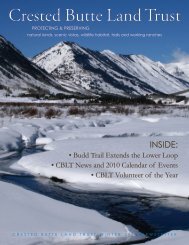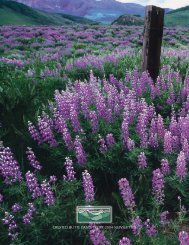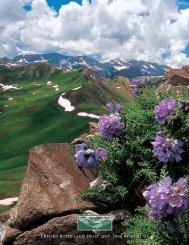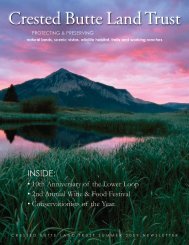You also want an ePaper? Increase the reach of your titles
YUMPU automatically turns print PDFs into web optimized ePapers that Google loves.
anching<br />
Round ‘em up<br />
R<br />
anching is part of our heritage. “It’s part of our history,” says Rudy Rozman, who comes from a family that has been<br />
ranching in the Gunnison Valley for more than 100 years. “Back then, there were only two reasons to come here—mining and<br />
ranching. That was the way of life.”<br />
That way of life paints an image of hay fields, lush,<br />
green pastures, cattle grazing at the base of snow dusted<br />
mountains… a romantic picture, far away from the crowded<br />
feed lots.<br />
Rudy Rozman<br />
“It provides several indirect contributions to the community,” says<br />
Curtis. “These include critical wildlife habitat, hunting and fishing<br />
opportunities, open space with undeveloped view sheds, cultural<br />
heritage, water rights that help keep water in our valley for all users,<br />
and stewardship of grazing lands both private and public.”<br />
Ranchers drive their cattle up and down the valley following the<br />
seasons and the forage growth. Starting in the late spring, cattle are<br />
driven to low altitude pastures that grow sufficient grass early in the<br />
grazing season. They are then gradually driven to higher altitudes as<br />
the season progresses. The herds start moving back down the valley<br />
in the fall as winter approaches and are eventually fed harvested hay<br />
when winter sets in.<br />
There’s the rancher, atop a steed, rounding up herds of healthy<br />
cattle from one pasture to another, whether it be by way of<br />
Highway 135 or a high mountian valley. In the Gunnison<br />
Valley, cattle drives are as much of a tradition as they are a<br />
necessary part of ranching.<br />
“Ranching in the Gunnison Valley has been one of the oldest<br />
and most stable drivers of the local economy and contributes<br />
$35-$40 million dollars annually to the valley,” says Curtis<br />
Allen, a fourth generation rancher. His family has been<br />
ranching here since 1886.<br />
Hedda Peterson<br />
There’s no exact science when it comes to moving cattle. It’s<br />
dependent on weather, forage, and outside factors. “Sometimes we move cattle every few days and in other situations, they<br />
may be moved only once every thirty days,” says Curtis.<br />
“A day planner is good for meetings, not moving cattle,” says Rudy,<br />
who has a few cattle drives under his belt. And, it’s a process that<br />
takes experience to learn. “You learn the characteristics of the herd<br />
and how to round them up.”<br />
Rudy and Curtis, like many ranchers, have seen a great deal of<br />
evolution to cattle driving. One of the largest obstacles is increased<br />
traffic on the road, making the use of trucks an attractive option.<br />
The cattle are gathered into a corral and loaded on to the trucks.<br />
They are then hauled to the new location and unloaded.<br />
Hedda Peterson “You would think it’s the cowboy around the campfire, while one<br />
plays the guitar,” says Rudy, with a laugh. “And not the cowboy<br />
at home watching Monday Night Football.” No matter the method used to move cattle, it’s a process that will continue to<br />
evolve—as ranchers in the Gunnison Valley provide healthy, sustainable food for our country.








